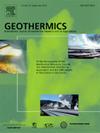Lithospheric thermal structure in the Dongpu Depression, Bohai Bay Basin, North China
IF 3.9
2区 工程技术
Q3 ENERGY & FUELS
引用次数: 0
Abstract
The Dongpu Depression is located in the eastern part of the North China Craton, which is the central region of lithospheric destruction and thinning of the North China Craton. The North China Craton is considered an ideal laboratory for studying the thinning and modifications of the ancient lithosphere. Based on rock thermal properties, the present geothermal field, and crustal structure, the thermal lithospheric thickness was calculated using a one-dimensional steady-state heat conduction equation. Assuming that heat is transferred by conduction and that rock thermal conductivity and radiogenic heat production rates are constant, a crustal model is developed. The heat flow generated by radioactive elements is calculated layer by layer through the "back stripping" method, which allows the determination of crustal heat flow, mantle heat flow, and Moho temperature. The results reveal that the thermal lithospheric thickness in the Dongpu Depression varies between 81.9 km and 90.8 km, with mantle heat flow ranging from 37.5 mW/m² to 42.0 mW/m². The ratio of mantle heat flow to surface heat flow is 60.8 %, and the temperature at the Moho interface ranges from 646 °C to 701 °C. These findings suggest a thin thermal lithosphere, a high ratio of mantle to surface heat flow, and elevated Moho temperatures, indicative of a “hot mantle and cold crust” lithospheric thermal structure. The lithospheric thermal structure of the Dongpu Depression indicates that its formation was controlled by extensional tectonics since the Cenozoic, the subduction of the western Pacific Plate, later plate retreat, and deep fault activities including the Lanliao, Yellow River, and Changyuan faults within the basin. This study may offer valuable heat source data for exploring geothermal and oil and gas resources in the Dongpu Depression.
渤海湾盆地东濮凹陷岩石圈热结构
东濮凹陷位于华北克拉通东部,是华北克拉通岩石圈破坏减薄的中心区域。华北克拉通被认为是研究古代岩石圈减薄和变化的理想实验室。基于岩石热性质、现今地热场和地壳结构,采用一维稳态热传导方程计算热岩石圈厚度。假设热量通过传导传递,岩石导热系数和放射成因产热率恒定,建立了地壳模型。放射性元素产生的热流通过“反剥法”逐层计算,可以确定地壳热流、地幔热流和莫霍温度。结果表明,东濮凹陷热岩石圈厚度在81.9 ~ 90.8 km之间,地幔热流在37.5 ~ 42.0 mW/m²之间。地幔热流与地表热流之比为60.8%,莫霍界面温度范围为646 ~ 701℃。这些发现表明,热岩石圈薄,地幔热流与地表热流之比高,莫霍温度升高,表明岩石圈热结构为“热幔冷壳”。东濮凹陷岩石圈热结构特征表明,其形成受新生代以来伸展构造、西太平洋板块俯冲、后期板块后退以及盆地内兰辽断裂、黄河断裂、长垣断裂等深部断裂活动的控制。该研究可为东濮凹陷地热和油气资源勘探提供有价值的热源资料。
本文章由计算机程序翻译,如有差异,请以英文原文为准。
求助全文
约1分钟内获得全文
求助全文
来源期刊

Geothermics
工程技术-地球科学综合
CiteScore
7.70
自引率
15.40%
发文量
237
审稿时长
4.5 months
期刊介绍:
Geothermics is an international journal devoted to the research and development of geothermal energy. The International Board of Editors of Geothermics, which comprises specialists in the various aspects of geothermal resources, exploration and development, guarantees the balanced, comprehensive view of scientific and technological developments in this promising energy field.
It promulgates the state of the art and science of geothermal energy, its exploration and exploitation through a regular exchange of information from all parts of the world. The journal publishes articles dealing with the theory, exploration techniques and all aspects of the utilization of geothermal resources. Geothermics serves as the scientific house, or exchange medium, through which the growing community of geothermal specialists can provide and receive information.
 求助内容:
求助内容: 应助结果提醒方式:
应助结果提醒方式:


